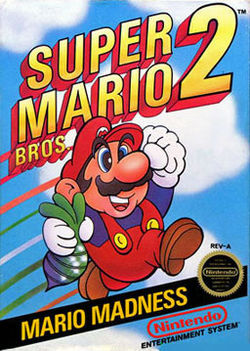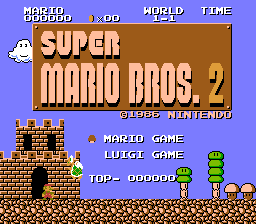Pidgits totally appeared in Super Mario World. I should know, I played the game for Halloween! To see a pidgit, one must complete the bonus world obtained by finding the secret exit in the last Star Road stage, then find a stage with horizontally-fired Bullet Bills. Instead of Bullet Bills, Pidget Bills are fired! Or something like that. They're definitely pidgits, though.
Double The Fun? - Mario Mania #2
Two games in one part! Can you guess which one I like better?

Different things usually happened with Nintendo in two completely different continents. While the NES arrived in 1986 in North America, Japan was already in its third year of Famicom glory. Nintendo’s then-released Famicom Disk System introduced the battery back-up save feature, eliminating the need for long over-drawn password saves. Games like Metroid and The Legend of Zelda greatly benefited from this innovation. It was also this year that Nintendo saw fit to release a sequel to Super Mario Bros, appropriately titled Super Mario Bros. 2. This was a completely different Super Mario Bros. 2 than the one North Americans got in 1988. So what in the world happened?
The answer was simple: the game was hard, bordering on maddening difficultly. Shigeru Miyamoto and his EAD team let their imaginations run wild and created all sorts of devious levels that only the bravest and most skilled of Mario gamers would be able to accomplish. Apparently the challenge was not appreciated by Nintendo of America, which complained that it was too hard and too similar to the original game. A more moderate difficulty level was needed, they reasoned, if Mario were to stay successful outside Japan.


Dream Factory: Doki Doki Panic would be the answer to their problems. Released by Fuji Television and Nintendo in 1987 for the Famicom Disk System, Miyamoto’s team took this completely different game set in a completely different world, changed the four playable characters into Mario characters, added some animation here and there, and sent it off to North America as Super Mario Bros. 2 where it went on to sell ten million units. The frustrating Japanese version disappeared until 1993, where it was dubbed The Lost Levels in the Super Mario All-Stars remake collection on Super Nintendo.




Comments